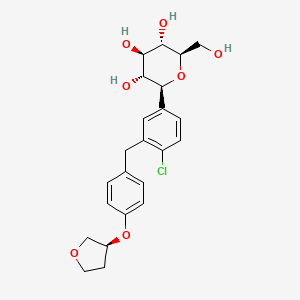
Empagliflozina
Descripción general
Descripción
Empagliflozina es un medicamento oral utilizado principalmente para controlar la diabetes mellitus tipo 2. Pertenece a la clase de medicamentos conocidos como inhibidores del cotransportador de sodio-glucosa 2 (SGLT2). Al inhibir el SGLT2, la this compound reduce la reabsorción de glucosa en los riñones, lo que lleva a una mayor excreción de glucosa a través de la orina. Esto ayuda a reducir los niveles de azúcar en sangre en pacientes con diabetes tipo 2 .
Aplicaciones Científicas De Investigación
La empagliflozina tiene una amplia gama de aplicaciones de investigación científica, que incluyen:
Manejo de la diabetes: La this compound se utiliza principalmente para controlar la diabetes tipo 2 al reducir los niveles de azúcar en sangre
Beneficios cardiovasculares: Las investigaciones han demostrado que la this compound puede reducir el riesgo de eventos cardiovasculares, como ataques cardíacos y accidentes cerebrovasculares, en pacientes con diabetes tipo 2
Protección renal: Se ha encontrado que la this compound tiene efectos nefoprotectores, reduciendo el riesgo de progresión de la enfermedad renal.
Insuficiencia cardíaca: El compuesto también se utiliza para tratar la insuficiencia cardíaca, proporcionando beneficios más allá del control de la glucosa.
Mecanismo De Acción
La empagliflozina ejerce sus efectos inhibiendo el cotransportador de sodio-glucosa 2 (SGLT2) en los riñones. Esta inhibición reduce la reabsorción de glucosa del filtrado glomerular, lo que lleva a una mayor excreción de glucosa a través de la orina. La reducción de los niveles de glucosa en sangre ayuda a controlar la diabetes tipo 2. Además, se ha demostrado que la this compound tiene efectos cardioprotectores y nefoprotectores, que se cree que están mediados por mecanismos como la reducción del estrés oxidativo y la mejora de la función endotelial .
Métodos De Preparación
Rutas sintéticas y condiciones de reacción: La empagliflozina se sintetiza a través de un proceso de varios pasos que involucra varios intermediarios clave. Una ruta sintética común involucra los siguientes pasos:
Formación del Intermediario I: El paso inicial involucra la reacción de 4-cloro-3-(4-(tetrahidrofurano-3-iloxi)bencil)fenil con un donador de glucosilo adecuado para formar el Intermediario I.
Formación del Intermediario II: El Intermediario I se somete a reacciones adicionales, que incluyen pasos de protección y desprotección, para producir el Intermediario II.
Acoplamiento final: El Intermediario II se acopla entonces con un donador de glucosilo adecuado en condiciones básicas para formar this compound
Métodos de producción industrial: La producción industrial de this compound normalmente involucra la síntesis a gran escala utilizando condiciones de reacción optimizadas para garantizar un alto rendimiento y pureza. El proceso incluye:
Reflujo: La mezcla de reacción se somete a reflujo para facilitar la formación del producto deseado.
Purificación: El producto bruto se purifica utilizando técnicas como la recristalización y la cromatografía para obtener this compound con alta pureza
Análisis De Reacciones Químicas
Tipos de reacciones: La empagliflozina se somete a varias reacciones químicas, que incluyen:
Hidrólisis: El compuesto es susceptible a la hidrólisis, especialmente en condiciones ácidas y básicas.
Reactivos y condiciones comunes:
Degradación oxidativa: Reactivos como el peróxido de hidrógeno u otros agentes oxidantes pueden inducir la degradación oxidativa.
Hidrólisis: Las condiciones ácidas o básicas, como el ácido clorhídrico o el hidróxido de sodio, pueden facilitar la hidrólisis.
Principales productos formados:
Productos de degradación oxidativa: Se pueden formar varios productos de oxidación, dependiendo de las condiciones y reactivos específicos utilizados.
Productos de hidrólisis: La hidrólisis puede llevar a la formación de fragmentos más pequeños y productos de degradación.
Comparación Con Compuestos Similares
La empagliflozina forma parte de la clase de medicamentos inhibidores del SGLT2. Otros compuestos similares en esta clase incluyen:
Canagliflozina: Otro inhibidor del SGLT2 utilizado para controlar la diabetes tipo 2.
Dapagliflozina: Este compuesto también se utiliza para tratar la diabetes tipo 2 y ha sido aprobado para su uso en la insuficiencia cardíaca.
Ertugliflozina: Otro inhibidor del SGLT2 con mecanismos de acción similares pero diferentes propiedades farmacocinéticas.
Singularidad de la this compound: La this compound es única en su alta selectividad para el SGLT2 sobre el SGLT1, lo que contribuye a su perfil de eficacia y seguridad. También se ha demostrado que tiene beneficios cardiovasculares y renales significativos, lo que la convierte en una opción valiosa para pacientes con diabetes tipo 2 y enfermedades concomitantes .
Propiedades
IUPAC Name |
(2S,3R,4R,5S,6R)-2-[4-chloro-3-[[4-[(3S)-oxolan-3-yl]oxyphenyl]methyl]phenyl]-6-(hydroxymethyl)oxane-3,4,5-triol | |
|---|---|---|
| Source | PubChem | |
| URL | https://pubchem.ncbi.nlm.nih.gov | |
| Description | Data deposited in or computed by PubChem | |
InChI |
InChI=1S/C23H27ClO7/c24-18-6-3-14(23-22(28)21(27)20(26)19(11-25)31-23)10-15(18)9-13-1-4-16(5-2-13)30-17-7-8-29-12-17/h1-6,10,17,19-23,25-28H,7-9,11-12H2/t17-,19+,20+,21-,22+,23-/m0/s1 | |
| Source | PubChem | |
| URL | https://pubchem.ncbi.nlm.nih.gov | |
| Description | Data deposited in or computed by PubChem | |
InChI Key |
OBWASQILIWPZMG-QZMOQZSNSA-N | |
| Source | PubChem | |
| URL | https://pubchem.ncbi.nlm.nih.gov | |
| Description | Data deposited in or computed by PubChem | |
Canonical SMILES |
C1COCC1OC2=CC=C(C=C2)CC3=C(C=CC(=C3)C4C(C(C(C(O4)CO)O)O)O)Cl | |
| Source | PubChem | |
| URL | https://pubchem.ncbi.nlm.nih.gov | |
| Description | Data deposited in or computed by PubChem | |
Isomeric SMILES |
C1COC[C@H]1OC2=CC=C(C=C2)CC3=C(C=CC(=C3)[C@H]4[C@@H]([C@H]([C@@H]([C@H](O4)CO)O)O)O)Cl | |
| Source | PubChem | |
| URL | https://pubchem.ncbi.nlm.nih.gov | |
| Description | Data deposited in or computed by PubChem | |
Molecular Formula |
C23H27ClO7 | |
| Source | PubChem | |
| URL | https://pubchem.ncbi.nlm.nih.gov | |
| Description | Data deposited in or computed by PubChem | |
DSSTOX Substance ID |
DTXSID601026093 | |
| Record name | Empagliflozin | |
| Source | EPA DSSTox | |
| URL | https://comptox.epa.gov/dashboard/DTXSID601026093 | |
| Description | DSSTox provides a high quality public chemistry resource for supporting improved predictive toxicology. | |
Molecular Weight |
450.9 g/mol | |
| Source | PubChem | |
| URL | https://pubchem.ncbi.nlm.nih.gov | |
| Description | Data deposited in or computed by PubChem | |
Mechanism of Action |
The vast majority of glucose filtered through the glomerulus is reabsorbed within the proximal tubule, primarily via SGLT2 (sodium-glucose linked co-transporter-2) which is responsible for ~90% of the total glucose reabsorption within the kidneys. Na+/K+-ATPase on the basolateral membrane of proximal tubular cells utilize ATP to actively pump Na+ ions into the interstitium surrounding the tubule, establishing a Na+ gradient within the tubular cell. SGLT2 on the apical membrane of these cells then utilize this gradient to facilitate secondary active co-transport of both Na+ and glucose out of the filtrate, thereby reabsorbing glucose back into the blood – inhibiting this co-transport, then, allows for a marked increase in glucosuria and decrease in blood glucose levels. Empagliflozin is a potent inhibitor of renal SGLT2 transporters located in the proximal tubules of the kidneys and works to lower blood glucose levels via an increase in glucosuria. Empagliflozin also appears to exert cardiovascular benefits - specifically in the prevention of heart failure - independent of its blood glucose-lowering effects, though the exact mechanism of this benefit is not precisely understood. Several theories have been posited, including the potential inhibition of Na+/H+ exchanger (NHE) 1 in the myocardium and NHE3 in the proximal tubule, reduction of pre-load via diuretic/natriuretic effects and reduction of blood pressure, prevention of cardiac fibrosis via suppression of pro-fibrotic markers, and reduction of pro-inflammatory adipokines. | |
| Record name | Empagliflozin | |
| Source | DrugBank | |
| URL | https://www.drugbank.ca/drugs/DB09038 | |
| Description | The DrugBank database is a unique bioinformatics and cheminformatics resource that combines detailed drug (i.e. chemical, pharmacological and pharmaceutical) data with comprehensive drug target (i.e. sequence, structure, and pathway) information. | |
| Explanation | Creative Common's Attribution-NonCommercial 4.0 International License (http://creativecommons.org/licenses/by-nc/4.0/legalcode) | |
CAS No. |
864070-44-0 | |
| Record name | Empagliflozin | |
| Source | CAS Common Chemistry | |
| URL | https://commonchemistry.cas.org/detail?cas_rn=864070-44-0 | |
| Description | CAS Common Chemistry is an open community resource for accessing chemical information. Nearly 500,000 chemical substances from CAS REGISTRY cover areas of community interest, including common and frequently regulated chemicals, and those relevant to high school and undergraduate chemistry classes. This chemical information, curated by our expert scientists, is provided in alignment with our mission as a division of the American Chemical Society. | |
| Explanation | The data from CAS Common Chemistry is provided under a CC-BY-NC 4.0 license, unless otherwise stated. | |
| Record name | Empagliflozin [USAN:INN] | |
| Source | ChemIDplus | |
| URL | https://pubchem.ncbi.nlm.nih.gov/substance/?source=chemidplus&sourceid=0864070440 | |
| Description | ChemIDplus is a free, web search system that provides access to the structure and nomenclature authority files used for the identification of chemical substances cited in National Library of Medicine (NLM) databases, including the TOXNET system. | |
| Record name | Empagliflozin | |
| Source | DrugBank | |
| URL | https://www.drugbank.ca/drugs/DB09038 | |
| Description | The DrugBank database is a unique bioinformatics and cheminformatics resource that combines detailed drug (i.e. chemical, pharmacological and pharmaceutical) data with comprehensive drug target (i.e. sequence, structure, and pathway) information. | |
| Explanation | Creative Common's Attribution-NonCommercial 4.0 International License (http://creativecommons.org/licenses/by-nc/4.0/legalcode) | |
| Record name | Empagliflozin | |
| Source | EPA DSSTox | |
| URL | https://comptox.epa.gov/dashboard/DTXSID601026093 | |
| Description | DSSTox provides a high quality public chemistry resource for supporting improved predictive toxicology. | |
| Record name | (2S,3R,4R,5S,6R)-2-(4-chloro-3-(4-((S)-tetrahydrofuran-3-yloxy)benzyl)phenyl)-6-(hydroxymethyl)tetrahydro-2H-pyran-3,4,5-triol | |
| Source | European Chemicals Agency (ECHA) | |
| URL | https://echa.europa.eu/information-on-chemicals | |
| Description | The European Chemicals Agency (ECHA) is an agency of the European Union which is the driving force among regulatory authorities in implementing the EU's groundbreaking chemicals legislation for the benefit of human health and the environment as well as for innovation and competitiveness. | |
| Explanation | Use of the information, documents and data from the ECHA website is subject to the terms and conditions of this Legal Notice, and subject to other binding limitations provided for under applicable law, the information, documents and data made available on the ECHA website may be reproduced, distributed and/or used, totally or in part, for non-commercial purposes provided that ECHA is acknowledged as the source: "Source: European Chemicals Agency, http://echa.europa.eu/". Such acknowledgement must be included in each copy of the material. ECHA permits and encourages organisations and individuals to create links to the ECHA website under the following cumulative conditions: Links can only be made to webpages that provide a link to the Legal Notice page. | |
| Record name | EMPAGLIFLOZIN | |
| Source | FDA Global Substance Registration System (GSRS) | |
| URL | https://gsrs.ncats.nih.gov/ginas/app/beta/substances/HDC1R2M35U | |
| Description | The FDA Global Substance Registration System (GSRS) enables the efficient and accurate exchange of information on what substances are in regulated products. Instead of relying on names, which vary across regulatory domains, countries, and regions, the GSRS knowledge base makes it possible for substances to be defined by standardized, scientific descriptions. | |
| Explanation | Unless otherwise noted, the contents of the FDA website (www.fda.gov), both text and graphics, are not copyrighted. They are in the public domain and may be republished, reprinted and otherwise used freely by anyone without the need to obtain permission from FDA. Credit to the U.S. Food and Drug Administration as the source is appreciated but not required. | |
Retrosynthesis Analysis
AI-Powered Synthesis Planning: Our tool employs the Template_relevance Pistachio, Template_relevance Bkms_metabolic, Template_relevance Pistachio_ringbreaker, Template_relevance Reaxys, Template_relevance Reaxys_biocatalysis model, leveraging a vast database of chemical reactions to predict feasible synthetic routes.
One-Step Synthesis Focus: Specifically designed for one-step synthesis, it provides concise and direct routes for your target compounds, streamlining the synthesis process.
Accurate Predictions: Utilizing the extensive PISTACHIO, BKMS_METABOLIC, PISTACHIO_RINGBREAKER, REAXYS, REAXYS_BIOCATALYSIS database, our tool offers high-accuracy predictions, reflecting the latest in chemical research and data.
Strategy Settings
| Precursor scoring | Relevance Heuristic |
|---|---|
| Min. plausibility | 0.01 |
| Model | Template_relevance |
| Template Set | Pistachio/Bkms_metabolic/Pistachio_ringbreaker/Reaxys/Reaxys_biocatalysis |
| Top-N result to add to graph | 6 |
Feasible Synthetic Routes
Descargo de responsabilidad e información sobre productos de investigación in vitro
Tenga en cuenta que todos los artículos e información de productos presentados en BenchChem están destinados únicamente con fines informativos. Los productos disponibles para la compra en BenchChem están diseñados específicamente para estudios in vitro, que se realizan fuera de organismos vivos. Los estudios in vitro, derivados del término latino "in vidrio", involucran experimentos realizados en entornos de laboratorio controlados utilizando células o tejidos. Es importante tener en cuenta que estos productos no se clasifican como medicamentos y no han recibido la aprobación de la FDA para la prevención, tratamiento o cura de ninguna condición médica, dolencia o enfermedad. Debemos enfatizar que cualquier forma de introducción corporal de estos productos en humanos o animales está estrictamente prohibida por ley. Es esencial adherirse a estas pautas para garantizar el cumplimiento de los estándares legales y éticos en la investigación y experimentación.



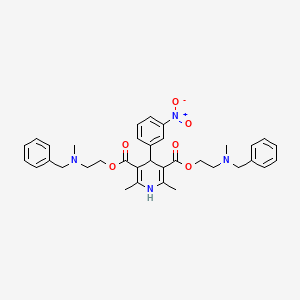

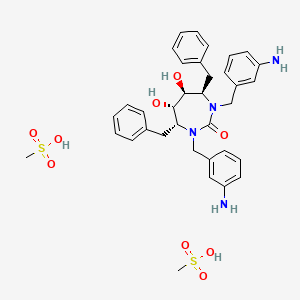
-lambda5](/img/structure/B1684246.png)



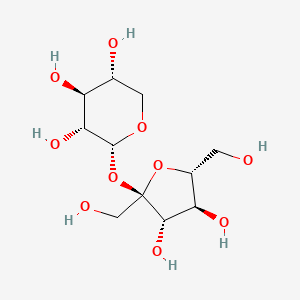
![1-Ethyl-4-[(1E,3E,5E,7E,9E,11E,13E,15E,17E)-18-(1-ethylpyridin-1-ium-4-yl)-3,7,12,16-tetramethyloctadeca-1,3,5,7,9,11,13,15,17-nonaenyl]pyridin-1-ium;dibromide](/img/structure/B1684252.png)
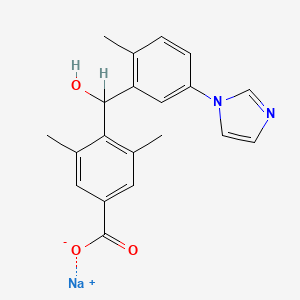
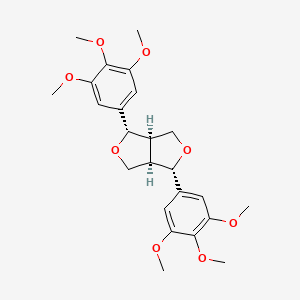
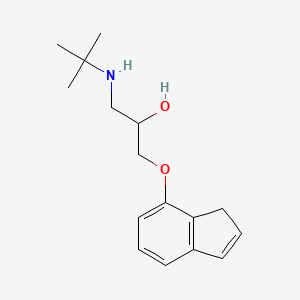
![2-[3-Cyano-5-(3,4-dichlorophenyl)-4,5-dimethylfuran-2-ylidene]propanedinitrile](/img/structure/B1684258.png)
